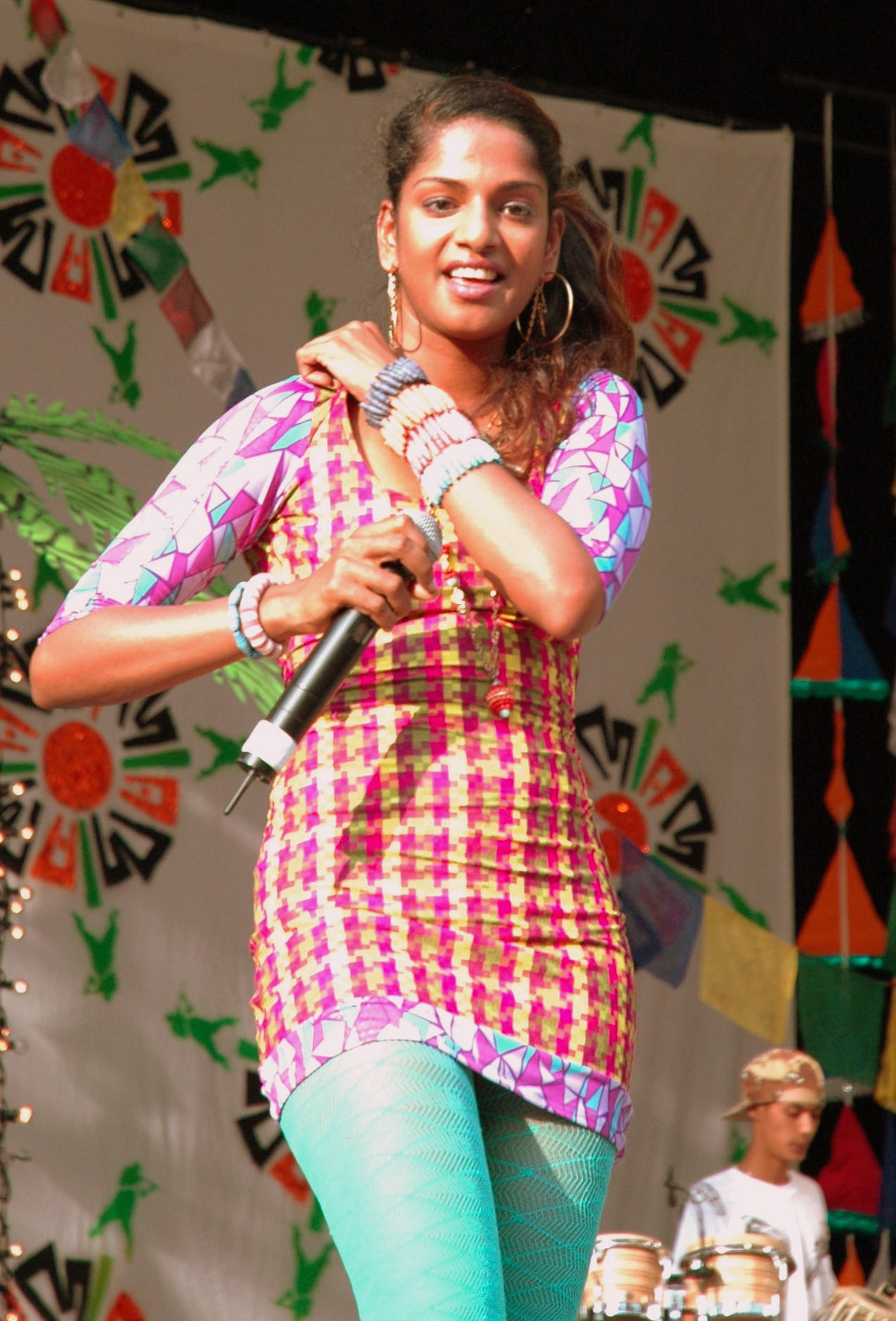M.I.A.'s Guerilla Tactics
 The following originally appeared in the August 2005 Central Park SummerStage program, written for people to read as they sat sweltering in the sun and waiting for the show to begin. M.I.A. was already pretty well known--though obviously not as famous as she would become after her single “Paper Planes” became a surprise hit three years later.
The following originally appeared in the August 2005 Central Park SummerStage program, written for people to read as they sat sweltering in the sun and waiting for the show to begin. M.I.A. was already pretty well known--though obviously not as famous as she would become after her single “Paper Planes” became a surprise hit three years later.
In terms of the highly unoriginal question at the center of this piece—would M.I.A. have to abandon her revolutionary ways to become a success?—I haven’t quite decided. Plenty of people would say she sold out years ago, but I don’t know too many sellouts who would dance around the Grammy stage literally hours before having a baby, or who would give the finger to several million people during a Superbowl half-time show.
Underground dance star M.I.A. is a godsend for music journalists. Her back-story is so interesting it practically writes itself, and every article about her since she emerged last year has featured the salient points. The twenty-nine year old Sri Lankan—born Maya Arulpragasam in London—is the daughter of a major figure in Sri Lanka’s Tamil separatist movement. She spent her first eleven years in that increasingly violent country, before fleeing with most of her family and eventually resettling in one of Outer London’s most run down housing projects. Maya learned English listening to Public Enemy and N.W.A. An art school grad and filmmaker, she discovered the charms of the Roland MC-505 Groovebox (the drum-machine/synthesizer on which she writes most of her songs) while filming a tour documentary for Britpop band Elastica. With the encouragement of Elastica’s leader Justine Frischman and underground dance/punk star Peaches, Arulpragasam ditched the camera and started making music. M.I.A.’s fame spread over the Internet, where her single “Galang” was distributed via mp3 blogs and file-sharing sites. With its blend of nonsense rhymes and thick immigrant slang, “Galang” became a sleeper hit.
After tinkering for months on her debut Arular, she gave most of the tracks away to the American-born DJ Diplo, who blended in bits of Jay-Z, Missy Elliott, The Bangles, and Jamaican toaster Cutty Ranks to produce an amazingly enjoyable mix tape called Piracy Funds Terrorism. The two posted the tape for free download on the Internet, and threw copies into the audience at shows. Instead of sabotaging her debut, the stunt generated so much buzz that even relatively staid publications like The New Yorker, Rolling Stone and The New York Times took notice. When Arular proper finally came out in March, it was hailed as one of the best albums of 2005—and this only three months into the year.
So is M.I.A. worth all the fuss? Well, yes, but not because of that bio (or her undeniable outsider glamour). Her music is fiercely creative and catchy, and there’s a homemade quality that sets it apart from polished commercial dance tracks. M.I.A. essentially makes 21st century folk-music, which is to say she sticks sounds together with cheap electronics and a lyrical outlook that appeals as much to young South Asian club goers as to ironic Williamsburg hipsters. The beats come from everywhere: Indian bhangra, Brazilian baile funk, the theme from “Sanford & Son.” In one verse, M.I.A. can drop a line of perfectly credible Jamaican patois, then name check The Pixies and Lou Reed.
Of course, she’s not the only one engaging in this type of beat-driven border crossing. What sets M.I.A. apart from other post-modern, sonic collage constructing dancehall divas is a peculiar balance between pop frivolity and radical politics. While she’s trying to reach a wide audience (“I want people to listen to me while they’re playing bingo in Swansea,” she said last year in The New Yorker), she risks alienating that audience with some of her subject matter. Even when the music is at its sunniest, the lyrics simmer with violence—violence not fueled by the outlaw fantasies of hard-core rap, but by the bleak realities of Third World poverty and the resentment of the West in engenders. M.I.A. incorporates these elements so artfully, you may find yourself dancing to a song about teenage prostitutes, racial profiling or, perhaps most troubling, terrorists. Arular’s opener, “Pull Up The People,” seems to flirt with suicide bombing with the same verve that N.W.A. once glamorized car-jacking. Though M.I.A. never endorses the violence she portrays, her songs have a nasty kick that can leave a listener off-balance, not sure how much to forgive. Certainly she is unabashed in her appropriation of rebel iconography, from the crude stencils of Molotov cocktails and rock-throwing youths that adorn the Arular packaging to the animated sticks of dynamite that usher one onto her website. Is she merely appropriating an air of danger in the same way that Joe Strummer of the Clash used to wear a Red Brigades t-shirt on stage? Or is she really ready to storm the barricades?
To be fair, only a few of her songs could be interpreted as being from a terrorist’s point of view, and one track, “Amazon,” is explicitly about a terrorist’s victim. M.I.A is estranged from her father and she apparently called her album Arular—her father’s nom de guerre—in order to mock him. In interviews, she has said she wants to provoke discussion, that it’s important to see everyone as humans first and political animals second. But pop music has never been about nuance, and if you’re going to promote yourself with images of bombs and jungle fighters, some people will take it at face value. M.I.A.’s rise so far has been remarkable, especially in America. But whether or not she’ll be able to ultimately break out of the underground may depend on the ability of western pop listeners to get past the guerilla imagery. Will she have to abandon the rebellion to reach those bingo players in Swansea?
